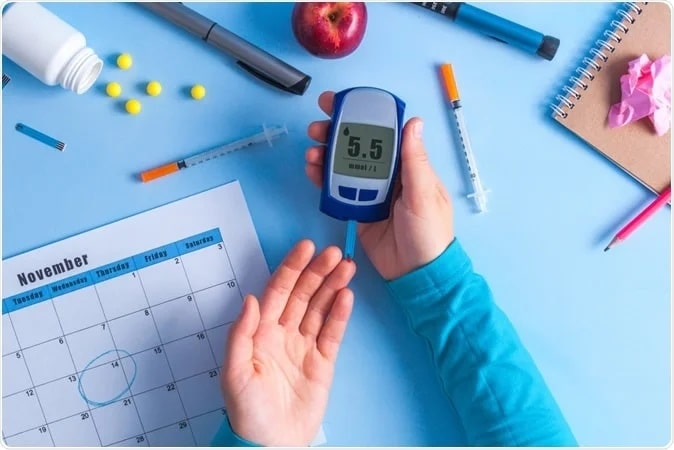What is Type 1 Diabetes?
Type 1 diabetes or insulin-dependent diabetes is a long-term disease that occurs when the pancreas cannot produce enough insulin for the body.
Insulin is needed by the body to control glucose (sugar) in cells obtained from the blood.
In people with diabetes, the glucose in the blood cannot be absorbed by the body’s cells, causing various symptoms and complications.
Symptoms of Type 1 Diabetes
Some symptoms of type 1 diabetes include:
- Frequent urination, especially at night ( polyuria ).
- Sering haus (polydipsia).
- Often feeling hungry ( polyphagia ).
- Weight loss even though diet remains the same.
- Blurred vision.
- Constant fatigue.
- Easily attacked by infectious diseases.
- A wound that takes a long time to heal.
- Feeling stiff or tingling in the legs.
In people with type 1 diabetes, symptoms can occur suddenly. It is best not to ignore when you experience health complaints related to type 1 diabetes symptoms.
Risk Factors for Type 1 Diabetes
Some risk factors for this condition include:
1. Genetic Factors
A person with a family history of this type of diabetes is at greater risk of developing the same disease.
It is related to mutations in the HLA gene that produces proteins for the immune system. However, not all parents can pass on the disease to their offspring.
2. Geographical Factors
People living in areas far from the equator, such as Finland and Sardinia, are most likely to develop type 1 diabetes.
This is caused by a lack of vitamin D which can be obtained from sunlight, which ultimately triggers autoimmune diseases.
3. Age Factor
This disease is most often detected in children aged 4-7 years, then in children aged 10-14 years.
4. Other Factors
Other triggering factors include consuming cow’s milk at too early an age, water containing sodium nitrate, cereals, and gluten before the age of 4 months or after 7 months, having a mother with a history of preeclampsia, and having jaundice at birth.
Causes of Type 1 Diabetes
The cause of diabetes is the inability of the pancreas to produce enough insulin so that glucose in the blood cannot enter the cells.
This pancreatic disorder is thought to be due to an autoimmune process, which is when a person’s immune system attacks healthy body cells.
In type 1 diabetes, the immune system attacks and damages beta cells in the pancreas, so they cannot produce enough insulin.
Several things that can cause damage to pancreatic beta cells include viral infections (enterovirus, Epstein-Barr virus, rubella virus, rotavirus, and mumps virus), consumption of certain medications, and the effects of gluten.
Diagnosis of Type 1 Diabetes
A doctor will diagnose someone with type 1 diabetes by conducting a medical interview, physical examination, and supporting examinations, such as:
- Blood and urine tests to determine glucose content in the body.
- HbA1c test to check the average level of glucose in the patient’s blood for the last 2 to 3 months.
- Autoantibody testing to differentiate between type 1 and 2 diabetes.
Complications of Type 1 Diabetes
If not treated immediately, type 1 diabetes can cause the following complications:
- Diabetic Retinopathy. Damage to blood vessels in the retina that can potentially lead to blindness.
- Diabetic Neuropathy. Damage to the small blood vessels and nerves, causing symptoms of tingling in the fingertips that can spread to other parts of the body, nausea, vomiting, diarrhea, and constipation.
- Heart Disorders and Stroke. This disease can trigger coronary heart disease due to the increased risk of atherosclerosis, due to high blood glucose levels.
- Diabetic Nephropathy. Kidney damage due to disruption of the renal blood vessels due to high blood glucose.
- Sexual Dysfunction. Type 1 diabetes triggers sexual dysfunction resulting in erectile dysfunction, decreased sexual satisfaction, lack of sexual desire, failure to achieve orgasm, pain during intercourse, and vaginal dryness.
- Pregnancy Disorders. Miscarriage and stillbirth in fetuses if blood glucose levels are not treated fairly.
- Skin Infections. People with type 1 diabetes are more likely to experience skin infections caused by bacteria or fungi.
Type 1 Diabetes Treatment
Diabetes cannot be cured. Treatment aims to maintain blood glucose levels and control symptoms.
In addition, treatment is also carried out to prevent complications that may occur later. Some of the treatments given by doctors include:
- Insulin to control the sufferer’s blood glucose. This insulin is given by injection into the layer under the skin about 3-4 times a day according to the dose recommended by the doctor.
- A healthy diet and regular exercise can help control blood glucose levels.
- Take care of your feet and have your eyes checked regularly to prevent further complications.
Prevention of Type 1 Diabetes
Prevention efforts for type 1 diabetes include:
- Undergo intensive treatment if there are family members who suffer from type 1 diabetes.
- Undergo a DNA test to determine the presence of genes that carry or cause type 1 diabetes.
- Follow a healthy diet.
- Do physical activity regularly.
- Control blood pressure and cholesterol.
- Regularly have check-ups and visit the hospital to control the disease.

